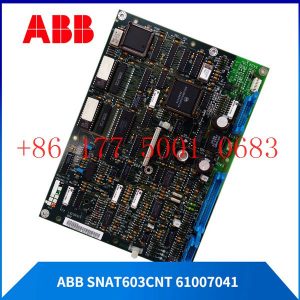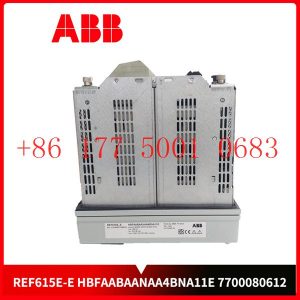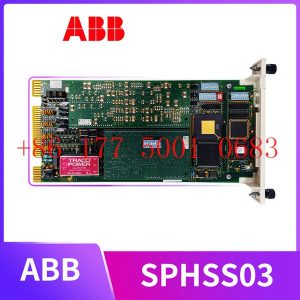Description
hardware flow control. It is an ideal choice in the field of industrial automation.
Implementation of communication between ABC industrial robot and PLC based on DeviceNet fieldbus technology
introduction
In modern production systems, industrial robots and PLCs need to communicate and collaborate to complete production tasks. That is, the
industrial robots output signals to the PLC, allowing the PLC to control related equipment to drive the robot”s front-end tools. This article
mainly analyzes the communication problems between ABB industrial robots and PLC based on DeviceNet fieldbus technology.
DeviceNet is a common network communication method in the field of automation. ABB industrial robots establish a network to communicate with
Siemens PLC based on the DeviceNet network.
1Configure DSQC652
There are mainly 5 types of standard I/0 boards commonly used in ABB industrial robots [2]. Except for the different addresses assigned to
them during setup, their configuration methods are basically the same. This article mainly analyzes the ABB standard I/0 board DS0C652, which
mainly builds communication modules based on the DeviceNet network. The DS0C652 board has a distributed I/O module with 16 digital input and 16
digital output interfaces. The board is installed in the ABB industrial robot control cabinet. First, define the specific operation steps of the DS0C652 board,
enter the teach pendant control panel, then enter the configuration menu (Figure 1), select the DeviceNetDevice menu, and add a template to enter Figure 2.
ABB standard I/0 board is hung on the DeviceNet
network, so the address of the module in the network must be set. The jumpers 6 to 12 of terminal x5 are used to determine the address of the module.
The available address range is 10 to 63. Modify the parameters in the template parameters to complete the DS0C652 board settings. Click the drop-down
menu to select the “Use value from template” row, select
“DS0C65224VDCI/0Device”, and then the parameters that need to be set include the address of the I/0 board in the bus.
Figure 1 Configuring DSQC652
2Configure signals and parameters
After completing the DS0C652 board setting, the I/0 signal setting will be performed. Setting the I/0 signal is the basis for establishing communication with
the PLC. The PLC communicates and transmits data with the ABB industrial robot through the I/0 signal and the DS0C652 board. As shown in Figure 3, in the
signal configuration interface, there are many default I/0 points after the system is established. Modification is not allowed. Click “Add” to add signals. When setting
input and output signals, their address range is 0~15. First, enter the signal menu in the configuration options to set the input and output types, and modify the corresponding parameters.
After completing the settings, the computer prompts that you need to restart the settings. If there are multiple signals that need to be defined and the waiting time
is long after restarting multiple times, you can click “Cancel” and wait for all signals to be defined before clicking the “Yes” button to restart. After the signal settings are
completed, click to select “Input and Output” in the ABB menu to check whether all signals have been set.
Figure 2 Configure DSQC652 parameters
Figure 3 Signal parameter settings
During the signal establishment process, attention should be paid to the DSoC652 port and PLC port addresses used, and the corresponding address table should be
established, as shown in Table 1. The robot interacts with the PLC through I/O signals. During the setting process, there must be no errors in the port and address number
of the PLC connected to the DSoC652. If the address is set incorrectly, the communication between the robot and the PLC will not work properly.
The entire robot teaching pendant setting process is shown in Figure 4.
https://www.xmamazon.com
https://www.xmamazon.com
https://www.plcdcs.com/
www.module-plc.com/
https://www.ymgk.com
169PLUS-120N-120 GE Multilin 169Plus relay
169PLUS-10C-120VAC GE Multilin 169Plus motor management relay
169-120N-120 GE Multilin 169Plus motor management relay
169PLUS-100N-125VDC GE Multilin Motor management relay
169-10C-120169-10C-120 GE relay
169-100P-120 GE Motor management relay
MMII-PD-MOD501-120 GE Motor protection system
DAPC100 3ASC25H203 ABB PC BOARD
MMII-PD-1-2-MOD600-120 GE Multilin Motor management relay
MMII-PD-1-2-240 GE Multilin MCC controller
MMII-PD-1-2-120 GE Multilin Display motor protection system
PMA323BE ABB PMA323BE HIEE300308R1 Control board module
PPA322B HIEE300016R2 HIEE400235R1 Control board module
UAC389AE02 ABB UAC389AE02 HIEE300888R0002 Control board module
CP451-50 Yokogawa CP451-50 processor module
GRBTU ABB GRBTU 3BSE013175R1 ABB Base
3BSE005461R1 ABB DSPC174 3BSE005461R1 Processor board
DSPC 174 ABB DSPC174 3BSE005461R1 Processor board
7DI140.70 B&R 7DI140.70 Digital input module
7AO352.70 B&R 7AO352.70 analog output module
7AI261.7 B&R 7AI261.7 Analog input module
IOP114 METSO IOP114 Input module
1747-L553/A AB 1747-L553/A SLC 5/05 processor
1747-L552/A ABB 1747-L552/A SLC 5/05 processor
216AB61 ABB 216AB61 HESG324013R100 Output module
216EA61b ABB 216EA61b HESG324015R1 Output module
PFEA112-65 ABB PFEA112-65 3BSE050091R65 tension electronic sensor
216NG63 ABB 216NG63 HESG441635R1 Output module
F404002A STEIN F404002A VISTA bus interface module
PM866AK01 ABB PM866K01 3BSE050198R1 Processor unit
3500/42M 176449-02 BENTLY 3500/42M 176449-02 Preprocessor/seismic monitor
REU615E_D ABB REU615E_D voltage protection measurement and control device
2713P-T12WD Alleny-Bradle 2713P-T12WD1 Analog resistance touch screen
5069-AENTR Allen-Bradley 5069-AENTR Compact 5000 Ethernet communication adapter
SPIET800 ABB SPIET800 Ethernet CIU transmission module
PR9376/010-021 EPRO PR9376/010-021 Speed sensor
PR 9376/010-01 EPRO Speed sensor PR9376/010-01
PR9376/010-001 EPRO PR9376/010-001 Speed sensor
PR9350/12 EPRO PR9350/12 Thermal expansion sensor
PR9350/08 EPRO PR9350/08 Thermal expansion sensor
PR9350/06 EPRO PR9350/06 Thermal expansion sensor
PR9350/04 EPRO PR9350/04 Thermal expansion sensor
PR9350/02 EPRO PR9350/02 Thermal expansion sensor
PR9350/01 EPRO PR9350/01 Thermal expansion sensor
MMS 6772 EPRO MMS6772 Dual current module
MMS 6771 EPRO MMS6771 Shaft vibration monitoring panel
MMS 3910/410-01 EPRO MMS3910/410-01 Dual current module
MMS 3910/311-32 EPRO MMS3910/311-32 Dual current module
MMS 3910/311-16 EPRO MMS3910/311-16 Rotational speed redundant module
MMS 3910/311-08 EPRO MMS3910/311-08 Dual current module
MMS 3910/311-04 EPRO MMS3910/311-04 Rotational speed redundant module
MMS3910/311-01 EPRO Speed direction module MMS3910/311-01
MMS3910/311-02 EPRO MMS3910/311-02 Limiting latching module
MMS 3311 EPRO MMS3311 speed transmitter
MMS 6822 EPRO MMS6822 Communication board
MMS 6831 EPRO Communication board MMS6831
MMS 6418 EPRO MMS6418 expansion monitoring board
MMS 6410 EPRO MMS6410 expansion monitoring board
MMS 6312 EPRO MMS6312 speed monitoring board
MMS 6310 EPRO MMS6310 Key phase monitoring board
MMS6253/TS EPRO MMS 6253/TS DAPS mother board
MMS 6250/D EPRO MMS6250/D Displacement plate
MMS6250 EPRO MMS 6250 Displacement plate
MMS6220 EPRO MMS6220 eccentric monitoring plate
MMS 6210 EPRO MMS6210 displacement monitoring plate
MMS 6140 EPRO MMS6140 vibration monitoring board
MMS 6110 EPRO Axial vibration monitoring board MMS6110









Reviews
There are no reviews yet.